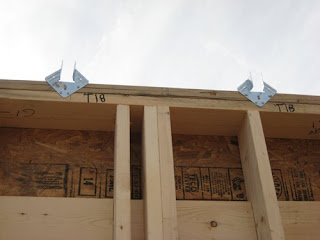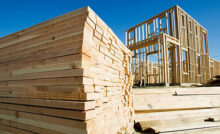

Typically pre-engineered trusses come with a set of engineering plans. The plans contain information about each type of truss, the truss plan layout and truss bracing details. The truss plan layout will identify the truss spacing and any special bearing plates or connectors.
For this new home there are about 20 different truss types. That may sound like a big number but there are common trusses, cathedral ceiling trusses, trayed ceiling trusses and gable trusses for each size. Most of the trusses bear directly on the wall top plate and get secured with truss hurricane clips (see the shiny galvanized connectors in the photo).


So a day or two before we receive a truss shipment we will lay out all of the trusses on top of the wall and attach the hurricane clips. This is a huge time saver on the day the trusses are delivered and erected. This approach also improves the overall safety of truss erection by eliminated confusion and allowing the carpenters to focus on what they are doing. We like to use a pair of pliers to slightly “open” up the hurricane clip to make it easier to drop the truss into place with the crane.
Please be sure to come back and read about the truss erection next week. I’ll cover basic safety guidelines for truss erection. This is extremely important as hundred of workers are hurt each year when trusses collapse during erection due to poor bracing and careless practices. If you enjoy this site I encourage you to simply sign up for my feed via RSS or an email subscription, it’s easy to do with the following two links.
Recent Posts
Framing Stick Nailer vs Coil Nailer
Which is Better a Stick Nailer or Coil Nailer? Framers have many choices in nailers…
How Many Roofing Nails Per Square of Shingles
Estimating How Many Nails for a New Roof When it comes to estimating materials for…
Composite / PVC Decking – Layout Tips & Advice
Composite / PVC Decking Layout Tips and Advice Composite and PVC decking have really changed…
Benefits of an ERV System (Energy Recovery Ventilator)
Benefits of ERV Systems (Energy Recovery Ventilator) If you're building a new home or doing…
Vermiculite Attic Insulation Abatement
Vermiculite Attic Insulation If your home was built before 1990 there is a chance it…
Nuisance Tripping of AFCI (Arc Fault) Circuit Breakers
Arc Fault (AFCI) Circuit Breakers Tripping Often An arc-fault circuit interrupter (AFCI) or arc-fault detection…

View Comments
You are correct that a lot of workers are injured during the installation of trusses. Most of the injuries should not have happend. The metal tie downs that you show are required by most if not all codes. They will be a trip hazard if installed before the trusses are nailed and braced correctly. This is a great site for information on installation of building components.
http://www.sbcindustry.com/jobsite.php
I am glad to see that there are construction firms that take the installation serious. Trusses fail every day because someone installed them like they always did. Roofs are far more difficult today than those built 10 years ago.
@ Jeff - They actually are not a trip hazard because we do not allow employees to walk the wall beyond the current truss they are working on. They must use a ladder at each location and go no further than the current truss.
Have you looked into a southern yellow pine top plate versus SPF? 9 times out of 10 it can be substituted to resist the crushing effect, especially at point load such as girders. I find, often, I can eliminate bearing enhansers with this simple but effective switch.